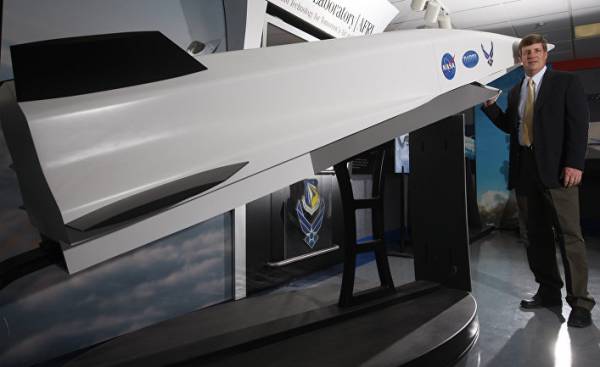
Scientists from Research laboratory of the U.S. air force (Air Force Research Laboratory) and the experts of the research Department of the Pentagon are working on a new hypersonic aircraft that can reach speeds of Mach 5, with on Board control system and other devices.
Senior officials of the air force stated that their experts will build on the successful test of a hypersonic missile X-51 Waverider to a height of 18 thousand meters, which was held in may 2013 over the Pacific ocean.
The U.S. air force and the Office of advanced research projects (DARPA) of the Pentagon plan to obtain new and improved model of the hypersonic aircraft by 2023. Rocket X-51, in fact, served as a proof of concept test, the purpose of which was to demonstrate that the missile with a ramjet engine can be started with the aircraft and achieve hypersonic speed.
Rocket with hypersonic motor has exceeded the speed of Mach 5, and so continued until, until it ran out of fuel. It was a very successful test run in the air of hypersonic weapons, emphasize the staff of the U.S. air force.
Successful tests were carried out was particularly good news for developers, as several previous tests of the missile X-51 Waverider failed.
Air force United States aggressively accelerate its efforts to develop hypersonic weapons, and all this is happening against the backdrop of recent reports that the Russians and Chinese also are testing hypersonic weapons.
In the recently published report of the Research Council of the United States air force (Air Force Studies Board) stresses that not only the United States are engaged in the development of machines capable of moving with such speed. This is stated in the statement of the U.S. air force.
It also said that China and Russia have conducted tests of hypersonic weapons, and some other countries are showing interest in developing technologies for hypersonic speeds.
“We need to push the boundaries of technology in all fields, said the air force chief of staff General David, Goldfein (David L. Goldfein) in a statement. — Our opponents are not sitting idly by. They use any opportunity to gain advantage”.
While American developers are expressing increasing concern about the progress of Russian and Chinese in the field of hypersonic weapons, they for the past few years are making progress in the area of hypersonic flight, as well as in the field of hypersonic weapons.
Describing the trajectory of hypersonic technologies through the “stairs”, the expert of the air force Jeffrey Zacarias (Geoffrey Zacharias) noted that gradual progress will require decades of continuous technological development.
While hypersonic unmanned reconnaissance flights already scheduled for 2030 years, the launch of reusable hypersonic drones can hardly be expected before 2040-ies, Zacarias said in an interview with the web site Warrior Scout.
The developers of the U.S. air force expect to use hypersonic intelligence, reconnaissance and observation drones in 2040-ies, when the scientific progress in the field of autonomy and the creation of engines will reach a new level.
The use of unmanned platforms, reusable, capable of travelling at high altitudes with speeds in excess of Mach 5, will cause the appearance of hypersonic weapons, which probably will go into service in mid 2020-ies. However, by 2040, the U.S. air force may have a hypersonic strike platform PPH (intelligence, reconnaissance, surveillance) that will be able to monitor and deliver military warheads, he added.
The technology of hypersonic weapons
Because hypersonic aircraft can travel on a parabolic trajectory, they rise at a very high altitude to reach hypersonic speeds and then return to lower altitude. Development UAVs are reusable is more difficult given the level of autonomy and return to the base, and they should decline to perform the tasks of intelligence, reconnaissance and surveillance”.
“Starting the engine allows the rocket to gain some altitude, and then she dives down and hits the target, said Zacarias, — Return the aircraft must have the necessary maneuverability and the corresponding area of the wing in order to be able to evade missiles. We need to develop such a device and make it stable to ensure that he got the opportunity to maneuver”.
The advantages of hypersonic drones that perform a function of intelligence, reconnaissance and surveillance, has many aspects. “You can run a machine, and it will cover a distance of 1,600 kilometers in ten minutes. This speeds up the chain of destruction,” he said.
Hypersonic drones can quickly hit located at a distance target, and perform a wide range of tasks, including the study of systems of air defense, surveillance and even targeted killings. Such drones are capable of significantly faster to identify targets at great distance, giving thus the ability of manned aircraft to stay at a safe distance.
Cruise missiles currently have a speed of 950 kilometers per hour, whereas a hypersonic device will be able to reach speeds from Mach 5 to Mach 10, emphasize the staff of the U.S. air force.
Hypersonic missiles, of course, will have an increased ability to destroy such targets as enemy ships, buildings, air defence systems and even drones and fixed wing aircraft or rotary-wing aircraft, and it will depend on available control technologies. Last year, the U.S. air force has conducted several “test flights” hypersonic aircraft in the framework of the joint program with Australia.
Among the remaining scientific challenges of achieving sustainable hypersonic flight of drones, can be called the development of the ability to operate at very high temperatures, said Zacarias.
The U.S. air force, apparently, will receive a deadly high-speed hypersonic weapon of distant radius of action in the middle of the 2020-ies, and this kind of missiles and aircraft will be able to move the charges with devastating kinetic energy for thousands of kilometers in the direction of enemy targets, and their speed will be five times larger than the speed of sound.
“This speed significantly increases their survival, and bring them down will be harder. If you supply them with a sufficient amount of fuel, they will have a good range. They move in the air roughly at the speed of 1.6 kilometers per second, and if you can provide fuel to the engine for 1000 seconds, the missile would cover a distance of 1,600 kilometers, which allows you to hit multiple targets at a considerable distance,” said Zacarias.
Although scientists of the U.S. air force from the Pentagon had already made considerable progress, much remains to be done before hypersonic aircraft and hypersonic weapons will be technologically ready for use in combat conditions.
“We are currently focused on finalizing the technology, that is, work is underway on a variety of fronts — control, navigation control, materials, ammunition, heat exchange, etc.,” said Zacarias.
High-speed drones and platforms, intelligence, reconnaissance and surveillance will have an improved ability to penetrate enemy airspace and quickly get out of it, and to send to its database important visual information, and thus they will remain invisible to radar and is not down.
The missile, moving at hypersonic speed would certainly cause more effective strikes on such targets as enemy ships, buildings, air defence systems and even drones, and aircraft with fixed-wing and rotorcraft, but everything will depend on available control technologies.
A key component in this case is the fact that these missiles fly at hypersonic speeds, that is a big problem for the goals we want to protect — they will have only seconds to respond or to defend yourself against approaching missiles.
Hypersonic weapons likely to be designed as attack weapons “kinetic impact”, and this means that the missile will not explosives, as the rate will be made only on the speed and force of impact to destroy the target.
“These missiles can have a huge kinetic energy for hitting fortified targets. Therefore, it is possible to reduce the weight of the warhead in the presence of higher kinetic energy. In fact, we are talking about speed and range. The Mach 5 is the speed, five times exceeding the speed of sound,” he said.
The speed of sound can vary, depending on the height; at ground level it is approximately 330 meters per second. Accordingly, if you fill the rocket with fuel at 2000 seconds, it can fly to the target of 600 kilometers.
“If it will be possible to control at low altitude at a speed of Mach 5, the range would be very significant,” said Zacarias.
Although, of course, the potential defensive use of hypersonic weapons — interceptors or aircraft, is also considered, the focus currently is on the development of offensive weapons that can quickly destroy enemy targets located at great distances.
Some missiles may have the ability that Zacarias calls the technology “planning and accelerate” (boost glide). This means that the first rocket beyond the earth’s atmosphere, and then use the rate of descent to strike at targets, as do raketoplana.
As an example, the Zacarias presented the experimental rocket plane the 1950-ies under the name X-15, which first had to climb to an altitude of 100 kilometers, and then back to the Earth’s surface.
China is testing hypersonic weapons
The Zacarias mentioned, and recent trials in China hypersonic weapons, which raised concerns in the Pentagon and among analysts dealing with existing threats.
Some analysts said that China has made progress in the development of hypersonic weapons, but Zacarias drew attention to the fact that many of the details regarding the tests are secret and therefore they are not available for analysis.
However, if China will have a hypersonic long-range weapons, this can have a significant impact on the situation, which in the Pentagon tout the restriction and prohibition of access (A2/AD).
 © AP Photo by Ty Greenlees/Dayton Daily NewsМодель hypersonic cruise missile X-51A Waverider
© AP Photo by Ty Greenlees/Dayton Daily NewsМодель hypersonic cruise missile X-51A Waverider
This phenomenon, designated A2/AD means that potential adversaries are using sensors long-range and precision weapons, can fully divest the armed forces of the United States the opportunity to act near some strategically important areas, including near the coast of enemy States. In addition, slow-moving aircraft carriers of the US Navy will be exposed to much greater danger.
Published 27 April last year on the website of Washington Free Beacon report, citing the Pentagon’s been said that China has successfully tested a warhead capable of maneuvering at high speeds.
“In tests you expect the aircraft DF-ZF was observed after it was launched using a ballistic missile on Friday from rocket center Ojai, located in the Central part of China, emphasized in the published on the official site of the Washington Free Beacon reported. — “Maneuvering the glider traveling at speeds of several thousand kilometers per hour, was seen by satellite during its flight in a westerly direction on the border of the atmosphere to a target area located in the Western part of the country.”
X-51 Waverider
Scientists from Research laboratory of the U.S. air force (Air Force Research Laboratory) and the experts of the research Department of the Pentagon are working on a new hypersonic aircraft that can reach speeds of Mach 5, with on Board control system and other devices.
Senior officials of the air force stated that their experts will build on the successful test of a hypersonic missile X-51 Waverider to a height of 18 thousand meters, which was held in may 2013 over the Pacific ocean.
The U.S. air force and the Office of advanced research projects (DARPA) of the Pentagon plan to obtain new and improved model of the hypersonic aircraft by 2023. Rocket X-51, in fact, served as a proof of concept test, the purpose of which was to demonstrate that the missile with a ramjet engine can be started with the aircraft and achieve hypersonic speed.
Rocket with hypersonic motor has exceeded the speed of Mach 5, and so continued until, until it ran out of fuel. It was a very successful test run in the air of hypersonic weapons, emphasize the staff of the U.S. air force.
Successful tests were carried out was particularly good news for developers, as several previous tests of the missile X-51 Waverider failed.
The 2013 test flight was the longest flight of a rocket with a jet engine and this was the result, beginning in 2004 of a technology demonstration program whose value, according to the staff of the U.S. air force amounted to $ 300 million.
Bomber B-52H Stratofortress took to the air missile X-51A, and at an altitude of 15 kilometers, it started solo flight for 26 seconds and accelerated to Mach indicators for 4.8. When the rocket was at an altitude of 18 kilometers, its speed increased to a max of 5.1.
Rocket X-51 transmit data to its fall into the sea, and this information is currently used by scientists in the development of more advanced hypersonic missiles.
“Having spent over 240 seconds their entire supply of fuel, the rocket continued to send to the control center telemetry data, and so continued until its fall in the water, after which it, as expected, collapsed,” — said in a published statement, the U.S. air force. — As a result of the experiment, data was collected, passed for 370 seconds.”
The new tests are aimed not just at creating another rocket it is planned to develop more complex aircraft, noted the experts of the U.S. air force.
For the creation of hypersonic missiles and aircraft require technology and materials capable of withstanding the high temperatures encountered at hypersonic velocities. Also needed is a control system operating at these speeds, said US air force personnel.
New tests will be carried out in parallel with the implementation of the program, the U.S. air force to create hypersonic weapons. Even though today’s cruise missiles have a speed of 900 kilometers per hour, hypersonic aircraft and missiles are able to reach speeds of Mach 5 to Mach 10, emphasize the staff of the U.S. air force.
Pentagon officials believe that this kind of hypersonic aircraft are expected to be less expensive than traditional missiles with turbine engines, since their production will require less detail.
For example, hypersonic, according to representatives of the U.S. air force, will be able to fly from new York to Los Angeles in about 30 minutes, not five hours like normal planes. However, the acceleration required to achieve hypersonic speeds, can eliminate the opportunity for a person to be inside of such an aircraft, or, at least, it can pose a serious challenge for scientists. A complete answer to this question has yet to receive.







